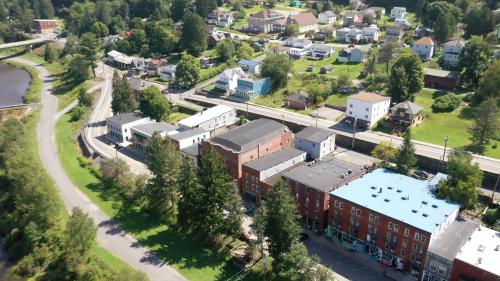This is the second in a two-part blog series capturing lessons from the first season of the Reimagine Rural podcast and offering policy recommendations to improve the effectiveness of federal rural policy. Note that links referring to the podcast will take the reader to specific interview transcripts and quotes.
The stories captured in the first season of the Reimagine Rural podcast offer important lessons at a pivotal policy moment for equitable rural development in the U.S. The current Congress is negotiating a new Farm Bill, the legislation agreed upon every five years that sets agricultural subsidies and authorizes the rural development programs managed by USDA (United States Department of Agriculture). Implementation is also underway for some of the most consequential place-based federal resources approved this century through the Infrastructure Investment and Jobs Act (IIJA), the CHIPs and Science Act (CHIPS), and the Inflation Reduction Act (IRA). All these pieces of legislation implicate rural places to a significant degree, either through programs exclusively focused on rural—or through programs that will necessarily include rural to a large degree.
To enable policy solutions that maximize the public benefit of these federal resources, the lessons from Reimagine Rural suggest a multi-pronged strategy that could be effective in the immediate term:
1. Shift the mindset from decline to opportunity
The podcast highlighted the diversity of economies that are emerging throughout rural America. While agriculture remains culturally and economically important in some places, it provides seven percent of aggregate rural employment, and the pursuit of off-farm employment by farmers continues to grow. At the same time, rural America is well-positioned for an array of new opportunities associated with clean energy and digital economies—solar farms, wind turbines, mineral mining, battery and chips manufacturing, data farms and distribution networks, and even innovation hubs. Many rural places are also seeking to strengthen their local entrepreneurial ecosystems and grow and diversify their locally owned enterprises. Seeing rural America as a place of opportunity, and focusing on policy to maximize the benefits of opportunities that lie beyond agriculture, must be the mindset of policymakers as they put together the Farm Bill and implement the resources approved in the recently passed legislation.
2. Invest in readiness
The podcast highlighted the challenges that local leaders, governments, and institutions face in accessing federal resources due to inadequate administrative capacity, expertise, and experience. Federal programs often exacerbate rather than ameliorate this situation: Match requirements make opportunities inaccessible, application processes are over-burdensome, and much of the funding is narrowly tied to physical pieces of infrastructure. This leaves little support for the “software” of community and economic development that was so evident and essential throughout the Reimagine Rural stories: staffing, partnerships with rural development hubs, and the creation of new local collaborations.
Recognition of these dynamics has led to a welcome focus on offering new funds for technical assistance, such as the $177 million investment in Environmental Justice Thriving Communities Technical Assistance Centers by the Environmental Protection Agency (EPA). Growing such efforts, especially ones associated with the programs being implemented through IIJA, CHIPs, and IRA, will be helpful. Yet such technical assistance funding is by definition often confined to a particular program, and it may not be specifically designed to meet the unique challenges and constraints faced by rural places.
A proposed rural investment initiative for the Farm Bill, based on the key elements of the previously suggested Rural Partnership Program, would offer flexible multi-year funding directly to rural communities to build capacity, hire staff, engage in pre-development activities, partner with rural intermediaries and experts, or strengthen local institutions and collaboration. The funds could also be used to provide a match for other federal programs. A portion of the funds would be set aside to strengthen national, regional, and local organizations that provide technical expertise and have proven track records in strengthening capacity in rural places—exactly the type of effective partners that local leaders described so regularly throughout the podcast. Given the urgency of the moment, a mandatory spending appropriation between $1-2.5 billion would make this a viable solution.
Such support could accelerate and scale up the work in local rural communities to develop shared priorities and create a pipeline of viable projects that has proven effective in accessing and absorbing public capital. The effort could also create a Rural Service Corps, placing fellows directly in rural towns to assist with local community and economic development initiatives, building on existing efforts such as the American Connection Corps and the Economic Recovery Corps. This combination of flexible and direct funding for local capacity; investment in partner organizations; and attraction of new human capital would be a significant step forward in helping a wide array of rural communities, especially those in persistent poverty or historically affected by political marginalization, to unlock the resources and opportunities reflected in the IIJA, CHIPs, and IRA.
3. Improve coherence
Federal programs available for rural community and economic development remain convoluted, fragmented, and spread throughout every part of the federal government—and new programs created by the IIJA, CHIPs, and the IRA will only exacerbate this. Penetrating the muddle that defines the supply of federal capital investment, and identifying which resources are most appropriate for a community’s purposes, remains daunting, especially for the most vulnerable rural communities. Improving coordination across the federal government and reducing the barriers for local communities are imperative.
The Biden administration has launched the Rural Partners Network (RPN) to place federal staff in vulnerable rural communities and work directly with local partnerships to identify which federal resources will best meet their unique needs. One of RPN’s most powerful elements is the Rural Prosperity Interagency Policy Council, a collaboration of 20 federal agencies and regional commissions co-led by the White House Domestic Policy Council and USDA to enhance coordination and ensure program design is sensitive to rural constraints. RPN is active in selected communities in ten states; the Farm Bill presents an opportunity to institutionalize its interagency process and authorize the program, so it can grow into more states and strengthen the coordination across the federal government.
4. Invest at a meaningful scale
Some communities are seeking to reverse declines that have been decades in the making—success will require persistence, stamina, and meaningful investment. Yet the size, flexibility, and consistency of capital available to communities that are ready, and have developed the capacity to take on transformational work, remains inadequate to the task. Policymakers must learn from experiments such as the $1 billion Build Back Better Regional Challenge launched by the Economic Development Administration (EDA) with funds from the American Rescue Plan Act, and continue to develop new programs where rural places can access large, flexible block grants at a scale large enough to give them a meaningful on-ramp toward economic transformation.
The implementation of the Recompete Pilot Program by EDA, approved as part of the CHIPs and Science Act, will invest $200 million in large grants to spur economic activity in persistently distressed areas. Incorporating a preference or carve-out for rural places would be a major step toward enabling the type of generational change that Brandon Dennison described will be necessary to scale up success across rural America. The Rebuild Rural America Act sponsored by Senator Kristen Gillibrand (D-NY) and Representative Nikki Budzinski (IL-13) also recognizes the need for large-scale investment, proposing block grants directly to regional rural councils.
5. Increase transparency
Learning about the types of successful approaches that podcast interviewees described, and understanding the depth and breadth of federal investments, remains too challenging, especially for the general public. The Rural Development Gateway recently launched by USDA-RD represents an important step in redressing this. But at this point, it provides information only on a narrowly defined set of funding mechanisms and lacks the ability to match important demographic characteristics—such as race, age, and sex—to the resource allocations. Improving the measurement of outcomes, increasing the accessibility of information on funding flows to rural areas from across the entire federal government, and enhancing the rigor of rural data could be facilitated by Farm Bill investments to update outdated information systems and ensure technology that is fit for purpose.
The experiences that local leaders recounted in Reimagine Rural reinforce the idea that federal rural policy would benefit from a systemic overhaul. The supply of public capital for economic and social transformation remains inaccessible and outdated, and U.S. policymakers lack a common vision for how rural places can and should thrive in the 21st–century economy. Larger considerations—such as creating a national rural policy, and reorganizing or even launching new bureaucratic structures—remain important and urgent considerations.
Yet the leaders who told their stories also demonstrated the wisdom in taking concrete, practical steps and working iteratively to build positive momentum even as they envision a more comprehensive transformation. These policy recommendations offer a similar opportunity: a set of feasible actions in the near term so the outcomes of the 2023 Farm Bill and the implementation of IIJA, CHIPs, and the IRA enable rural places to access capital and resources that will matter—and help them reimagine their economic and social futures.







Commentary
5 recommendations from Reimagine Rural for the 2023 Farm Bill and federal implementation
July 24, 2023